AMD Radeon HD 7950 Review Feat. Sapphire & XFX: Sewing Up The High-End Market
by Ryan Smith on January 31, 2012 9:02 AM ESTOverclocking: Power, Temp, & Noise
In their marketing materials AMD is heavily pushing overclocking, and they have good reason to. With the 7970 we’ve established that Tahiti has quite a bit of overclocking headroom, and as the 7950 is clocked lower by default this opens up that headroom even further. Realistically AMD’s binning process means that the best clocking Tahiti GPUs are going to be allocated to the 7970 unless they have failed shaders, but even with that there’s quite a bit of potential on paper.
As with overclocking the 7970, our goal overclocking the 7950 is to see how much you can get for free; that is without any voltage adjustments. AMD’s reference PCBs are not particularly overbuilt for overclocking—cards like that will come later—so sticking to the reference voltage is the safest option, not to mention the easiest. With the 7970 we were able to get 200MHz (22%) overclocks without any voltage adjustment, and we’re hoping for the same out of the 7950.
With that said, we quickly ran into a wall on one card: the Sapphire 7950. Sapphire’s low VID of 0.993v may be great for temperature and noise at stock, but it’s not doing overclocking any favors. We only hit 950MHz at that voltage. As the Sapphire was the odd man out—every other card was at 1.093v—we did end up overvolting the Sapphire to 1.093v to see what it was capable of when put on similar footing as the rest of our cards.
After bringing up the voltage of our Sapphire card, all of our 7950s ended up overclocking to very similar levels. Our Sapphire and AMD cards topped out at 1025MHz core, a 225MHz (28%) overclock over a stock 7950 and a 125MHz (14%) overclock over the Sapphire’s factory overclock, while our XFX card reached 1050MHz, a 150MHz (17%) overclock beyond XFX’s factory overclock. Meanwhile the memory clocks on all of our cards topped out at 5.8GHz, beyond which we’d start seeing performance regressions from error correction on the memory bus.
| Radeon HD 7950 Overclocking | |||||
| AMD Radeon HD 7950 | Sapphire HD 7950 Overclock Edition | XFX R7950 BEDD | |||
| Shipping Core Clock | 800MHz | 900MHz | 900MHz | ||
| Shipping Memory Clock | 5GHz | 5GHz | 5.5GHz | ||
| Shipping Voltage | 1.093v | 0.993v | 1.093v | ||
| Overclock Core Clock | 1025MHz | 1025MHz | 1050MHz | ||
| Overclock Memory Clock | 5.8GHz | 5.8GHz | 5.8GHz | ||
| Overclock Voltage | 1.093v | 1.093v | 1.093v | ||
As you can imagine, with such similar overclocks, gaming performance on all 4 cards ended up being very similar. So we’ll get to gaming performance in a minute, while we’ll start with power, temperature, & noise.
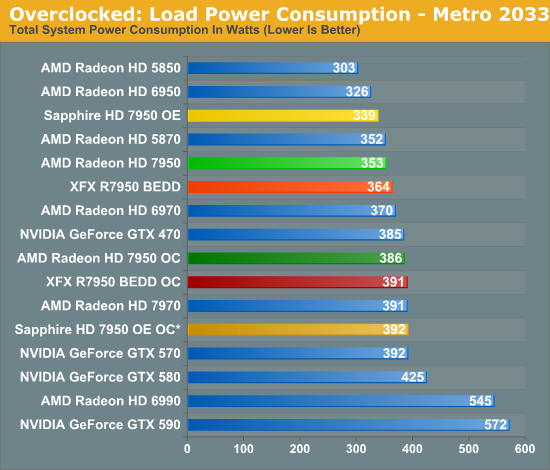

Even though we’re not increasing the voltage on our AMD and XFX cards, merely overclocking them and raising the PowerTune limit to avoid throttling does drive the power consumption up. As is typical with heavily overclocked cards, overclocking quickly drives up power consumption and the 7950s are no exception. After overclocking power consumption is almost identical to the stock 7970, so while you can get 7970 performance you still need to pay the price with 7970 power consumption. Meanwhile it’s interesting to note that even with the extra 0.1v we’ve given the Sapphire card its final power consumption is only ever so slightly higher than the other 7950s, proving that voltage is the great equalizer in this case.
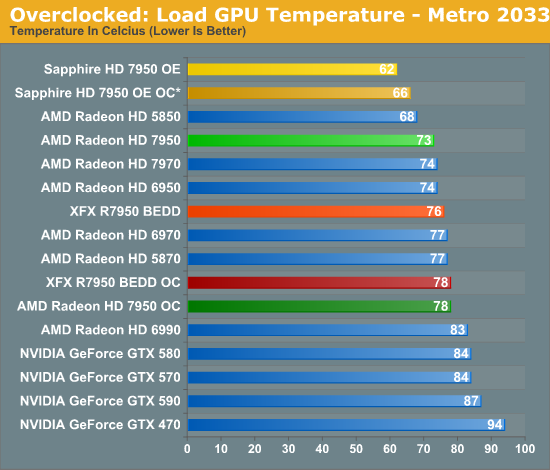
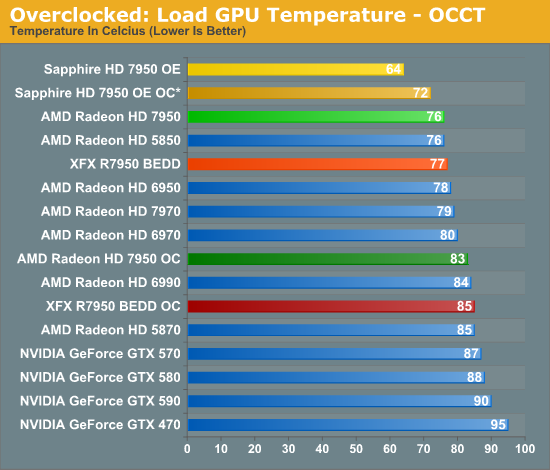
With the increase in power comes an increase in temperatures. The Sapphire card still does very well here staying in the low 70s even under OCCT, while the reference and XFX cards hit the high 70s under Metro and mid 80s under OCCT. As we’ve yet to really ascertain what the thermal limits are for Tahiti, it’s not clear whether there’s too much thermal headroom left for the GPU, particularly under OCCT.
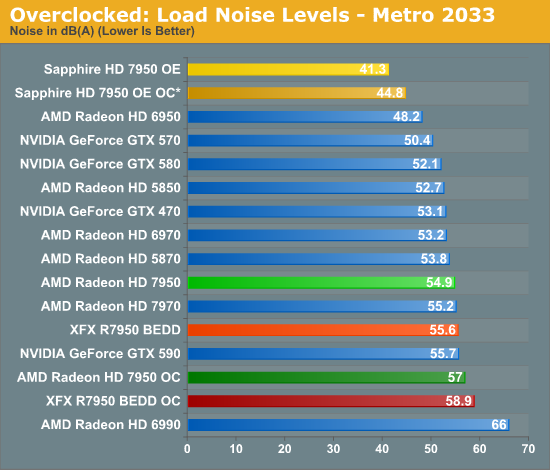
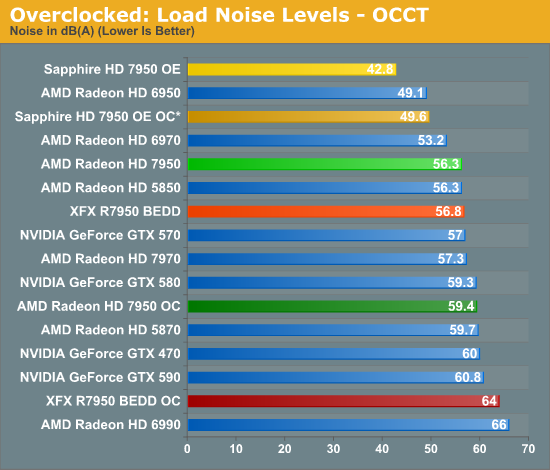
Last but not least we have load noise. The Sapphire card is once more a stellar performer, and we still can’t get it above 50dB even with OCCT. Unfortunately the XFX 7950 BEDD has its biggest fallout yet—it may be able to overclock well, but at 64dB under OCCT the performance isn’t going to be worth the immense amount of noise it creates to move enough air to keep the GPU cool.










259 Comments
View All Comments
chizow - Tuesday, January 31, 2012 - link
Now it starts to become obvious why people shouldn't be doing cartwheels in the streets over Southern Islands. Its a nice chip, it really is. But the problem with its pricing just became even more obvious with the 7950 as AMD is selling you yesterday's performance at next-gen prices. In other words, if you wanted this level of performance, you could've gotten it a year ago with the GTX 580 for almost the same price....over a year ago....And that's why AMD's pricing of these parts fails. With the 7950 it all comes into focus and if it wasn't clear before, it will become crystal once Kepler drives the nail home when it launches at its expected prices and performance levels. What's left for AMD to launch? A 7870 that's as fast as the 6970 but costs $50 more? A 7850 that's as fast as the 6950 but costs $75 more? Do we really think Nvidia is going to launch a 580 equivalent at 28nm and price it at $450? See how it all comes into focus?
But Nvidia really has a chance to return the favor to AMD here with a pricing debacle of GTX 260/280-esque proportions. If GK104 comes within spitting distance of the 7970 or even 7950 at $300, AMD is going to look really bad. If GK110 beats the 7970 by 20-25% and costs only $500, AMD execs will be jumping out of windows. We're talking about issuing rebate checks that AMD can't afford to write on every 7950/7970 sold at these ridiculous prices for however many months it takes until Nvidia releases Kepler.
Goty - Tuesday, January 31, 2012 - link
1) I believe you mean "consistently faster than last-gen performance for the same price", which is how it will remain until NVIDIA gets a card out that can compete.and
2) Keep dreaming.
chizow - Tuesday, January 31, 2012 - link
1) Well the good news is Nvidia decided to compete over a year ago when they launched the GTX 580. At these prices AMD has set, Nvidia is still amazingly competing with their 14 month old last-gen parts.and
2) The better news is AMD has set the bar extremely low for Nvidia. Should be easy pickings for Kepler.
halo37253 - Tuesday, January 31, 2012 - link
Yet a overclocked 7970 is about as fast as a gtx590, yeah... nvidia sure is competing. lolReally there is no reason to get a nvidia card right now, with the gtx580 and its continuing high costs not even able to hold its own again even a 7950. Once the 7xx series launches I can see AMD launching the hd89xx series no to long after with XDR2 memory and higher clocked cores.
For overall performance per watt it seems AMD cant be touched right now.
kashifme21 - Tuesday, January 31, 2012 - link
The real question is, Do we really need these upgrades anymore. I mean todays games barely push tech. Most of my friends are happy with their 5870's and GTX 480's we bought about 2 years backThing is games are designed with consoles in mind and with next gen console hardware rumors to be around the level of 6670 GPUs, why would anyone upgrade anymore, unless they intend to be running multiple screens.
I personally run GTX 580 SLI. I think i personally wont be upgrading until i see a game that actually stresses my system in eyefinity settings.
Its a sad state but many games recently released dont even support freatures like AA or even any pc options, games are rather straight console ports, with PC as an after thought. Why buy such expensive hardware for ports?
jleach1 - Tuesday, January 31, 2012 - link
I agree. Even my 5850 hasn't stressed much in recent games...and I bought it for 280 USD a couple years ago.Performance per dollars, and temp per dollar, AMD is on target, more often than not....now, if only we could get the FX sorted out...
I used to buy nvidia cards, but haven't since the 5000 series, and it looks to continue this way.
The moral is, competition is ultimately what brings prices down and motivation to up the performance.
I hope AMD can throw out something cool soon on the CPU side, because while I always have, and likely will continue to buy Intel, I love the competition. Sorry, I sorta gave up on AMD after the i7-930 came out. But that doesn't mean I'm not rooting for them...even if it is only for the sake of competition.
TerdFerguson - Tuesday, January 31, 2012 - link
On the other hand, upgrading the 5850 that you've had for several years is going to require you to jump to a /higher/ price tier. That's insanity. If that kind of pricing structure existed for ANY other consumer electronics product, people would be vocally antagonistic. AMD deserves some antagonism.JonnyDough - Wednesday, February 1, 2012 - link
I disagree. Supply and demand. They don't have the supply and there's a big enough demand to keep prices inflated. Nobody can be upset at all about the prices. If you don't like them, don't buy the product. It's that simple. Capitalism fails us often, but here's a case where it works just fine. :)TerdFerguson - Wednesday, February 1, 2012 - link
By your foolish reasoning, AMD would be in top form if it produced and sold just a couple of hand-crafted units each quarter. That they can't meet volume demand is a failing, not a benefit.artk2219 - Wednesday, February 1, 2012 - link
I've got to say that I agree with JohnnyDough, in the short term keeping prices high and making a killing off of each card sold is a good thing for AMD, not so great for us consumers but again, its not like anyone is forcing you to buy it. However you are correct in that in the long term that is a failing strategy for a company like AMD, its not like they're making luxury sports cars :). Either way it makes no difference to me and it puts them in a great position for a coming price war with Nvidia and Kepler which will inevitably be faster, I just hope Nvidia does something about their power profile.